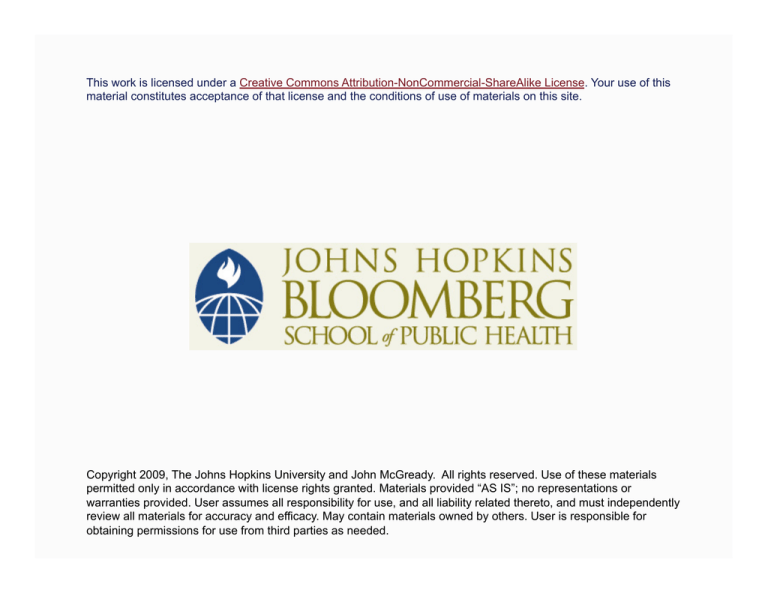
This work is licensed under a Creative Commons Attribution-NonCommercial-ShareAlike License. Your use of this
material constitutes acceptance of that license and the conditions of use of materials on this site.
Copyright 2009, The Johns Hopkins University and John McGready. All rights reserved. Use of these materials
permitted only in accordance with license rights granted. Materials provided “AS IS”; no representations or
warranties provided. User assumes all responsibility for use, and all liability related thereto, and must independently
review all materials for accuracy and efficacy. May contain materials owned by others. User is responsible for
obtaining permissions for use from third parties as needed.
Regression for Survival Analysis
John McGready
Johns Hopkins University
Lecture Topics
Cox proportional hazards (PH) regression
Interpreting coefficients from Cox PH regression
Performing inference on Cox PH regression coefficients
3
Section A
The Cox Proportional Hazard Regression Model
Multivariate Analysis
In Statistical Reasoning 1 we learned why we need a
different approach to analyzing time to event data in the
presence of censoring
We learned to estimate the “survival function” via the
Kaplan Meier method for a cohort of subjects
We learned to statistically compare the “survival
functions” of two or more cohorts via the logrank and
Wilcoxon-Gehan tests
Continued
5
Multivariate Analysis
However, those statistical tests did not provide an
estimate of the magnitude of the difference in survival
for the cohorts being compared
Further, the tests allowed for comparisons based on one
grouping factor (predictor) at a time
Continued
6
Multivariate Analysis
How can we get an estimate of the magnitude of the
survival-predictor relationship of interest?
How can we account for multiple factors simultaneously
for each subject in a time to event study?
How can we estimate adjusted survival-predictor
relationships in the presence of potential confounding?
7
Regression Methods for Censored Survival
Data
Objective
Relate survival times to (potentially multiple)
predictors (the x’s or independent variables)
Continued
8
Regression Methods for Censored Survival
Data
Problem
Can’t use ordinary linear regression because how
do you account for the censored data?
Can’t use logistic regression without ignoring the
time component
9
Proportional Hazards Regression Model
Developed by D.R. Cox (1972)
Relates survival time to predictors
Handles incomplete follow-up
Censoring
Continued
10
Proportional Hazards Regression Model
It assumes the ratio of time-specific outcome (event)
risks (hazard) of two groups remains about the same over
time
This ratio is called the hazards ratio or the relative risk
11
Proportional Hazards Assumption
All Cox regression requires is an assumption that ratio of
hazards is constant over time across groups
The good news—we don’t need to know anything about
overall shape of risk/hazard over time
The bad news—the proportionality assumption can be
restrictive
Continued
12
Proportional Hazards Assumption
Hazard
Smokers
Constant Ratio
Time
NonSmokers
Continued
13
Proportional Hazards Assumption
Carnivores
Hazard
Vegetarians
Vegans
Time
14
Cox Proportional Hazards Model
Formulation of model:
Group hazard
= Baseline hazard × “group factor”
Continued
15
Cox Proportional Hazards Model
Formulation of the model:
Continued
16
Cox Proportional Hazards Model
Such that . . .
Continued
17
Cox Proportional Hazards Model
312 patients with primary biliary cirrhosis (PBC) studied
at the Mayo clinic
Patients were followed from diagnosis until death or
censoring
Information available includes sex and age (years) of
each patient
Question—how do patient’s age and sex predict
survival?
18
Data as It Appears in Stata
Here is a snippet of the data:
Continued
19
Data as It Appears in Stata
The variables:
survyr is a time measurement in years
death is an indicator of death (1) or censoring (0)
sex is an indicator (1 = female, 0 = male)
ageyr is age in years
20
Letting Stata Know It Is Time to Event Data
The “stset” command tells Stata that we have time to
event data—Stata converts it internally and then we
have use of a bunch of built in commands
Syntax . . .
stset time_variable, failure(event_variable =1)
So for our data the syntax is . . .
stset survyr, failure(death=1)
Continued
21
Letting Stata Know It Is Time to Event Data
Here is what Stata does . . .
22
Using Stata for Survival Analysis
Let’s look at Kaplan-Meier curves by sex
Command: sts graph, by(sex)
Continued
23
Using Stata for Survival Analysis
To do a log rank test
Command: sts test, by(sex)
Continued
24
Using Stata for Survival Analysis
So there is visual evidence that females have longer
survival than males
The results of the log-rank test show a significant
difference in the survival experience of males and
females
However, so far we have no measure of the association
between longer survival and being female—how can we
get this?
25
Example
How about a regression model?
(here
is sex, 1 for females and 0 for males)
Continued
26
Example
Let’s figure out how to interpret
Model for females
Continued
27
Example
Let’s figure out how to interpret
Model for males
Continued
28
Example
Taking the difference
Continued
29
Example
Invoking our favorite property of logs
So is the log of the hazard ratio (relative risk) of death
for females compared to males
Continued
30
Example
Such that . . .
So
is the hazard ratio (relative risk) of death for males
to females
31
Interpreting Coefficients
Interpretation
> 0: Higher hazard (poorer survival) associated
with being female
Because > 1
Continued
32
Interpreting Coefficients
Interpretation
< 0: Lower hazard (better survival) associated
with being female
Because < 1
Continued
33
Interpreting Coefficients
Interpretation
= 0: No association between hazard (and
survival) and being female
Because = 1
34
Example
With a sample of data, we are only going to be
estimating —so the regression equation we estimate
from our sample of 312 patients looks like . . .
Continued
35
Example
For this dataset, the estimated regression equation is . . .
So
36
Interpretation
So we’ve estimated a negative association between
death and being female—the hazard (risk) of death is
lower for females in this sample
How to describe this association?
The estimate hazard ratio (relative risk) of death for
females relative to males is
= .62
Females have .62 the hazard (risk) that males have of
death (or females have 38% lower hazard (risk) of death
than males)
37
Getting Stata To Do the Work
The “stcox” command will estimate the regression
General syntax: stcox
Where
is the predictor of interest
Notice we do not need to specify an outcome (Stata
already knows it because we have declared the time and
censoring variables with the stset command!)
38
The Stata Output
Results from the stcox command
Continued
39
The Stata Output
Notice stcox does the conversion to the hazard ratio for
us!
If we wanted information about the coefficient,
could use the “nohr” option
General syntax: stcox
, we
, nohr
Continued
40
The Stata Output
Output with “nohr” option
41
Accounting for Sampling Variability
The coefficient and hazard ratio estimates are based on
an imperfect sample of 312 subjects from a large
population/process
To complete the story, we need to incorporate sampling
error into these estimates via a confidence interval and a
p-value
Continued
42
Accounting for Sampling Variability
Luckily, Stata does this for us!
Continued
43
Accounting for Sampling Variability
The confidence interval gives a range of plausible values
for the true hazard ratio of death for females compared
to males in the population of PBC patients
The p-values are testing . . .
: hazard ratio =1
: hazard ratio ≠ 1
Continued
44
Accounting for Sampling Variability
Describing the results
In a sample of 312 PBC patients, females had a lower
hazard (risk) of death than males. The estimated hazard
ratio was .62 indicating that females had 38% lower
hazard (risk) of death than males.
Accounting for sampling variability, the decrease in risk
for females could be as large as 62% or as small as 3%
(95% CI for the hazard ratio 0.38–0.97).
Continued
45
Accounting for Sampling Variability
Where do the CIs and p-value come from?
It turns out all inference is done on the coefficient scale
The 95% confidence interval for
is
The endpoints of this 95% CI can be exponentiated to
get the 95% CI for the hazard (risk) ratio
Continued
46
Accounting for Sampling Variability
Testing
:
= 0 is equivalent to testing
:
(hazard ratio) = 1
This is done by computing a test statistic :
And comparing to standard normal curve to get p-value
So its business as usual!
47
The Stata Output
Try it out using results below !
48





